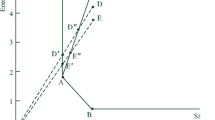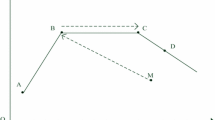Abstract
Total-factor energy efficiency (TFEE) assessment has received increasing attention in both operations research and energy economics communities. Earlier TFEE studies implicitly assume that production activity lies in the economic area, which precludes the possibility that the production activity lies in the non-economic area and thus suffers from congestion. This paper contributes to develop TFEE index by taking into account congestion effect. It starts with the definition of congested production technology, based on which several data envelopment analysis models are proposed to construct TFEE index with congestion. The models for quantifying energy inefficiency caused by congestion effect are also developed. We apply the proposed index to evaluate the energy efficiency performance of Chinese industrial sectors at province level in 2010–2012. It is found that TFEE with congestion can yield useful insights about the choice of proper ways to achieve energy efficiency improvement. A comparison with the empirical results under congestion-free production technology indicates that ignoring congestion effect may lead to significantly different TFEE scores when congestion effect does exist.




Similar content being viewed by others
Notes
DEA as a mainstream methodology for efficiency and productivity analysis has been employed in a wide range of areas, and this journal has reported some recent developments in the theory and applications of DEA (Emrouznejad 2014). An excellent example is the study by Chen (2014) which examined several key theoretical issues in measuring carbon performance.
One recent study by Wu et al. (2015c) offered interesting insights into total-factor energy efficiency evaluation by dividing the industrial systems into energy utilization stage and a pollution treatment stage.
Agriculture sector provides a typical example of input congestion in production area. Land is a ‘limiting input’ on which additional unit of labor on the same plot of land cause congestion, which also holds for other inputs such as water and fertilizer.
Cooper et al. (2001) and Flegg and Allen (2009) have identified labor congestion and capital congestion in the textile industry and automobile industry. Different from their work which only considered labor and capital inputs, a recent study by Wu et al. (2015b) examined the issue of energy congestion and found that the overuse of energy may also cause congestion in industrial sectors.
According to Färe and Grosskopf (1983), the assumption of weak disposability of inputs would not preclude congestion and could be well characterized within a nonparametric DEA framework.
For the case of variable returns to scale (VRS), an additional constraint \(\sum \limits _{i=1}^I {\lambda _i =1} \) is required to be added.
Model (3) can be converted to a weighted slacks-based DEA model (Fukuyama and Weber 2010) or a special form of non-radial directional distance function that does not consider output objective (Färe and Grosskopf 2010; Zhou et al. 2012a). However, it should be pointed out that a crucial difference between our TFEE measure and others is that our DEA models are conducted under the congested production technology.
The recent study by Wu et al. (2015b) proposed a decomposition model to examine the energy inefficiency caused by energy congestion. However, their overall energy inefficiency is based on the standard strong disposability assumption. Different from their method, we construct our models under the congested production technology. Besides, we propose a more general method by considering the effect of non-energy input congestion, such as labor congestion and capital congestion.
In addition to the two measures, the non-radial directional distance function approach has also been used to measure TFEE performance, e.g. Wang et al. (2013a). However, under a specific setting of direction vector, the method used by Wang et al. (2013a) will collapse to our energy-oriented measure.
References
Ang, B. W., Mu, A. R., & Zhou, P. (2010). Accounting frameworks for tracking energy efficiency trends. Energy Economics, 32, 1209–1219.
Ang, B. W., & Xu, X. Y. (2013). Track industrial energy efficiency trends using index decomposition analysis. Energy Economics, 40, 1014–1021.
Ang, B. W., Xu, X. Y., & Su, B. (2015). Multi-country comparisons of energy performance: The index decomposition analysis approach: The index decomposition analysis approach. Energy Economics, 47, 68–76.
Bi, G. B., Song, W., Zhou, P., & Liang, L. (2014). Does environmental regulation affect energy efficiency in China’s thermal power generation? Empirical evidence from a slacks-based DEA model. Energy Policy, 66, 537–546.
Bian, Y. W., He, P., & Xu, H. (2013). Estimation of potential energy saving and carbon dioxide emission reduction in China based on an extended non-radial DEA approach. Energy Policy, 63, 962–971.
Boyd, G. A. (2014). Estimating the changes in the distribution of energy efficiency in the U.S. automobile assembly industry. Energy Economics, 42, 81–87.
Boyd, G. A., & Pang, J. X. (2000). Estimating the linkage between energy efficiency and productivity. Energy Policy, 28, 289–296.
Chen, C. M. (2014). Evaluating eco-efficiency with data envelopment analysis: An analytical re-examination. Annals of Operations Research, 214, 49–71.
Cherchye, L., Kuosmanen, T., & Post, T. (2001). Alternative treatment of congestion in DEA: A rejoinder to Cooper, Gu, and Li. European Journal of Operational Research, 132, 75–80.
Chung, W., Zhou, G. H., & Yeung, I. M. H. (2013). A study of energy efficiency of transport sector in China from 2003 to 2009. Applied Energy, 112, 1066–1077.
Cooper, W. W., Deng, H. H., Gu, B. S., Li, S. L., & Thrall, R. M. (2001). Using DEA to improve the management of congestion in Chinese industries (1981–1997). Socio-Economic Planning Science, 35, 227–242.
Emrouznejad, A. (2014). Advances in data envelopment analysis. Annals of Operations Research, 214, 1–4.
Färe, R., & Grosskopf, S. (1983). Measuring congestion in production. Zeitschrift für Nationalökonomie, 43, 257–271.
Färe, R., & Grosskopf, S. (2010). Directional distance functions and slacks-based measures of efficiency. European Journal of Operational Research, 200, 320–322.
Filippini, M., & Hunt, L. C. (2012). US residential energy demand and energy efficiency: A stochastic demand frontier approach. Energy Economics, 34, 1484–1491.
Filippini, M., Hunt, L. C., & Zoric, J. (2014). Impact of energy policy instruments on the estimated level of underlying energy efficiency in the EU residential sector. Energy Policy, 69, 73–81.
Flegg, A. T., & Allen, D. O. (2009). Congestion in the Chinese automobile and textile industries revisited. Socio-Economic Planning Science, 43, 77–192.
Fukuyama, H., & Weber, W. L. (2010). A slacks-based inefficiency measure for a two-stage system with bad outputs. Omega, 38, 239–410.
Honma, S., & Hu, J. L. (2014a). Industry-level total-factor energy efficiency in developed countries: A Japan-centered analysis. Applied Energy, 119, 67–78.
Honma, S., & Hu, J. L. (2014b). A panel data parametric frontier technique for measuring total-factor energy efficiency: An application to Japanese regions. Energy, 78, 732–739.
Hu, J. L., & Wang, S. C. (2006). Total-factor energy efficiency of regions in China. Energy Policy, 34(17), 3206–3217.
Lin, B. Q., & Du, K. (2013). Technology gap and China’s regional energy efficiency: A parametric metafrontier approach. Energy Economics, 40, 529–536.
Mandal, S. K. (2010). Do undesirable output and environmental regulation matter in energy efficiency analysis? Evidence from Indian cement industry. Energy Policy, 38, 6076–6083.
Munkherjee, K. (2010). Measuring energy efficiency in the context of an emerging economy: The case of Indian manufacturing. European Journal of Operational Research, 201, 933–941.
National Bureau of Statistics of China (NBSC). (2013). China Statistical Yearbook 2013. Beijing: China Statistical Press.
Rødseth, K. L. (2013). A note on input congestion. Economics Letters, 120, 599–602.
Samuelson, R. D. (2014). The unexpected challenges of using energy intensity as a policy objective: Examining the debate over the APEC energy intensity goal. Energy Policy, 64, 373–381.
Shahiduzzaman, M., & Alam, K. (2013). Changes in energy efficiency in Australia: A decomposition of aggregate energy intensity using logarithmic mean Divisia approach. Energy Policy, 56, 341–351.
Wang, H., Zhou, P., & Zhou, D. Q. (2013a). Scenario-based energy efficiency and productivity in China: A non-radial directional distance function analysis. Energy Economics, 40, 795–803.
Wang, K., & Wei, Y. M. (2014). China’s regional industrial energy efficiency and carbon emissions abatement costs. Applied Energy, 130, 617–631.
Wang, K., Wei, Y. M., & Zhang, X. (2013b). Energy and emissions efficiency patterns of Chinese regions: A multi-directional efficiency analysis. Applied Energy, 104, 105–116.
Wang, Z., Feng, C., & Zhang, B. (2014). An empirical analysis of China’s energy efficiency from both static and dynamic perspectives. Energy, 74, 322–330.
Wei, Y. M., Liao, H., & Fan, Y. (2007). An empirical analysis of energy efficiency in China’s iron and steel sector. Energy, 32, 2262–2270.
Wu, F., Fan, L. W., Zhou, P., & Zhou, D. Q. (2012). Industrial energy efficiency with \(\text{ CO }_{2}\) emissions in China: A nonparametric analysis. Energy Policy, 49, 164–172.
Wu, F., Zhou, P., & Zhou, D. Q. (2014). Does congestion affect total-factor energy efficiency? A theoretical study. Energy Procedia, 61, 294–298.
Wu, F., Zhou, P., & Zhou, D. Q. (2015a). Measuring energy congestion in Chinese industrial sectors: A slacks-based DEA approach. Computational Economics, 46, 479–494.
Wu, F., Zhou, P., & Zhou. D. Q. (2015b). Does there exist energy congestion? Empirical evidence from Chinese industrial sectors. Energy Efficiency. doi:10.1007/s12053-015-9370-2.
Wu, J., Xiong, B., An, Q., Sun, J., & Wu, H. (2015c). Total-factor energy efficiency evaluation of Chinese industry by using two-stage DEA model with shared inputs. Annals of Operations Research. doi:10.1007/s10479-015-1938-x.
Zhang, N., Zhou, P., & Choi, Y. (2013). Energy efficiency, \(\text{ CO }_{2}\) emission performance and technology gaps in fossil fuel electricity generation in Korea: A meta-frontier non-radial directional distance function analysis. Energy Policy, 56, 653–662.
Zhou, P., & Ang, B. W. (2008). Linear programming models for measuring economy-wide energy efficiency performance. Energy Policy, 38, 2911–2916.
Zhou, P., & Ang, B. W. (2014). Index decomposition analysis for tracking energy efficiency trends. In S. Managi (Ed.), The Routledge Handbook of Environmental Economics in Asia (pp. 85–97). London: Routledge.
Zhou, P., Ang, B. W., & Poh, K. L. (2008). A survey of data envelopment analysis in energy and environment studies. European Journal of Operational Research, 189, 1–18.
Zhou, P., Ang, B. W., & Wang, H. (2012a). Energy and \(\text{ CO }_{2}\) emission performance in electricity generation: A non-radial directional distance function approach. European Journal of Operational Research, 221, 625–635.
Zhou, P., Ang, B. W., & Zhou, D. Q. (2012b). Measuring economy-wide energy efficiency performance: A parametric frontier approach. Applied Energy, 90, 196–200.
Zhou, P., Poh, K. L., & Ang, B. W. (2007). A non-radial DEA approach to measuring environmental performance. European Journal of Operational Research, 178, 1–9.
Zhou, P., Sun, Z. R., & Zhou, D. Q. (2014). Optimal path for controlling \(\text{ CO }_{2}\) emissions in China: A perspective of efficiency analysis. Energy Economics, 45, 99–110.
Acknowledgments
The authors are grateful to the financial support provided by the National Natural Science Foundation of China (Nos. 71273005, 71573119), the Jiangsu Natural Science Foundation for Distinguished Young Scholar (No. BK20140038), the Funding of Jiangsu Innovation Program for Graduate Education (CXLX13_170) and the NUAA research funding (No. NE2013104).
Author information
Authors and Affiliations
Corresponding authors
Rights and permissions
About this article
Cite this article
Zhou, P., Wu, F. & Zhou, D.Q. Total-factor energy efficiency with congestion. Ann Oper Res 255, 241–256 (2017). https://doi.org/10.1007/s10479-015-2053-8
Published:
Issue Date:
DOI: https://doi.org/10.1007/s10479-015-2053-8




